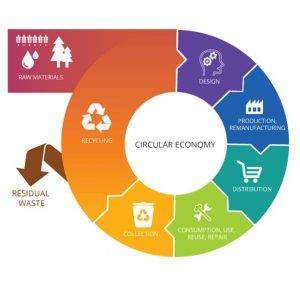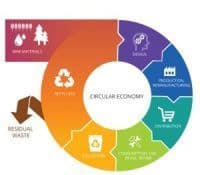Let’s Talk About the Transition to a Circular Economy!
Can you guess how much waste a person produces every day?
Wait, let us stop you there for a second! This will be a cycle of articles that will outline the effects of the circular economic model and how it relates to energy efficiency. Our goal is to give you information regarding this environmental issue and the circular economy practices as the solution. So be sure to pay attention to our articles as they are released! Okay, moving on…
Our global consumption in 2019 is about 40 Gt with the current linear economy model. In 2016, the total world’s population produces 2.1 billion tonnes of solid waste and estimated to increase 3.5 billion tonnes by 2050. 46% of this waste is disposed of without any follow-up treatment and turned into unsustainable waste. Lastly, of the total waste produced, companies are the ones producing the largest amount of waste each year.

This amount will be three times larger than today by 2060 if we keep using the linear economic model. We need to do something now to cut down on the waste we produce, since this number will only increase moving forward. One of the solutions that can help to eliminate a huge volume of waste is by using a new economic model, called the Circular Economy.
 The Circular Economy describes a systemic strategy that sets up long-term resilience, creates business and economic opportunities, and presents environmental and societal advantages. It is the opposite of the Linear Economic Model where the raw materials that we process into a product is thrown away after use. In a Circular Economy, the remaining materials are repurposed and processed into another product. It is more than just recycling, the model’s focus is to maximize the added value of a product in a sustainable way. The key to a Circular Economy is maximizing the value derived from materials.
The Circular Economy describes a systemic strategy that sets up long-term resilience, creates business and economic opportunities, and presents environmental and societal advantages. It is the opposite of the Linear Economic Model where the raw materials that we process into a product is thrown away after use. In a Circular Economy, the remaining materials are repurposed and processed into another product. It is more than just recycling, the model’s focus is to maximize the added value of a product in a sustainable way. The key to a Circular Economy is maximizing the value derived from materials.
The EU has been making progress integrating aspects of the Circular Economy, having already created 54 action plans to kick-start the changes. As of 2019, their goals of transitioning to a Circular Economic model have been achieved. The country that has led the initiative in transitioning to this economic model is Finland.
In October 2019, The Finnish Embassy in Indonesia arranged an event to introduce their experience transitioning to a Circular Economy. During the event, Finnish experts introduced the concept of a circular economy and how this concept can be applied in Indonesia. For a country to transition to a Circular Economy, two pillars must be followed. The first is to focus on policy actions and the second is gaining an understanding of best practices from large and small projects, pulling expertise from all levels. In the first pillar, Finland’s government supports countries to incorporate concepts of a Circular Economy in everyday life via new policies and legislation. The second pillar involves a hands-on approach with a proactive learning and development plan to take positive actions, such as decreasing waste.
How Indonesia can Follow Finland’s Example
After Finland successfully implemented a circular economy in their own country, they are now trying to educate other countries; in our case, Indonesia. If we compare Indonesia to Finland, Indonesia has a substantially larger geographic area and population, which of course means significantly more waste. As the fourth most populous country in the world, Indonesia has major problems in raising the awareness of environmental issues and waste management problems. Indonesia produced 190,000 tons of waste every day in 2019 with an average of 0.7 kg of waste produced by each citizen, most of which was organic waste. With 69% of the waste going to landfills without any recycling and 20% of all plastic waste ending up in rivers and oceans, it is clear that there is enormous potential for improvement.
The Indonesian government has not yet formulated a plan to solve these environmental issues. The only policies in place addressing environmental problems are ambiguous, and therefore ineffective at driving real change. Another limitation to implementing change is from the general public which has very little knowledge and awareness towards waste management problems. This is an area where the government of Finland can lend its expertise to recommend legislation and initiatives that can help educate the masses and drive positive behavioral change at all levels.
There is a reason for hope – local companies are popping up addressing the waste issues that are a problem throughout factories across Indonesia. Coming up with creative solutions that uses the waste generated from manufacturing will have a major impact on the overall waste problems that are present, and provides a way to incorporate the circular model to one of the industry’s most pressing problems.
As the largest producer of waste, industry has a responsibility to manage their waste effectively. This is especially relevant, as Indonesia positions itself as a major manufacturer for the world economy, more and more global companies want to be sure that their items are part of a ‘sustainable value chain’. There are many different ways manufacturers can take action to make these improvements, which we will be covering in our future posts.
Now that we have gone through the basics of a circular economy and provided background on how countries can manage that transition, let’s look forward. This is the first entry into a series of posts we will be releasing discussing different aspects of the Circular Economic model and how big industry, energy and waste initiatives, and everyday citizens can do their part to manage this transition.
